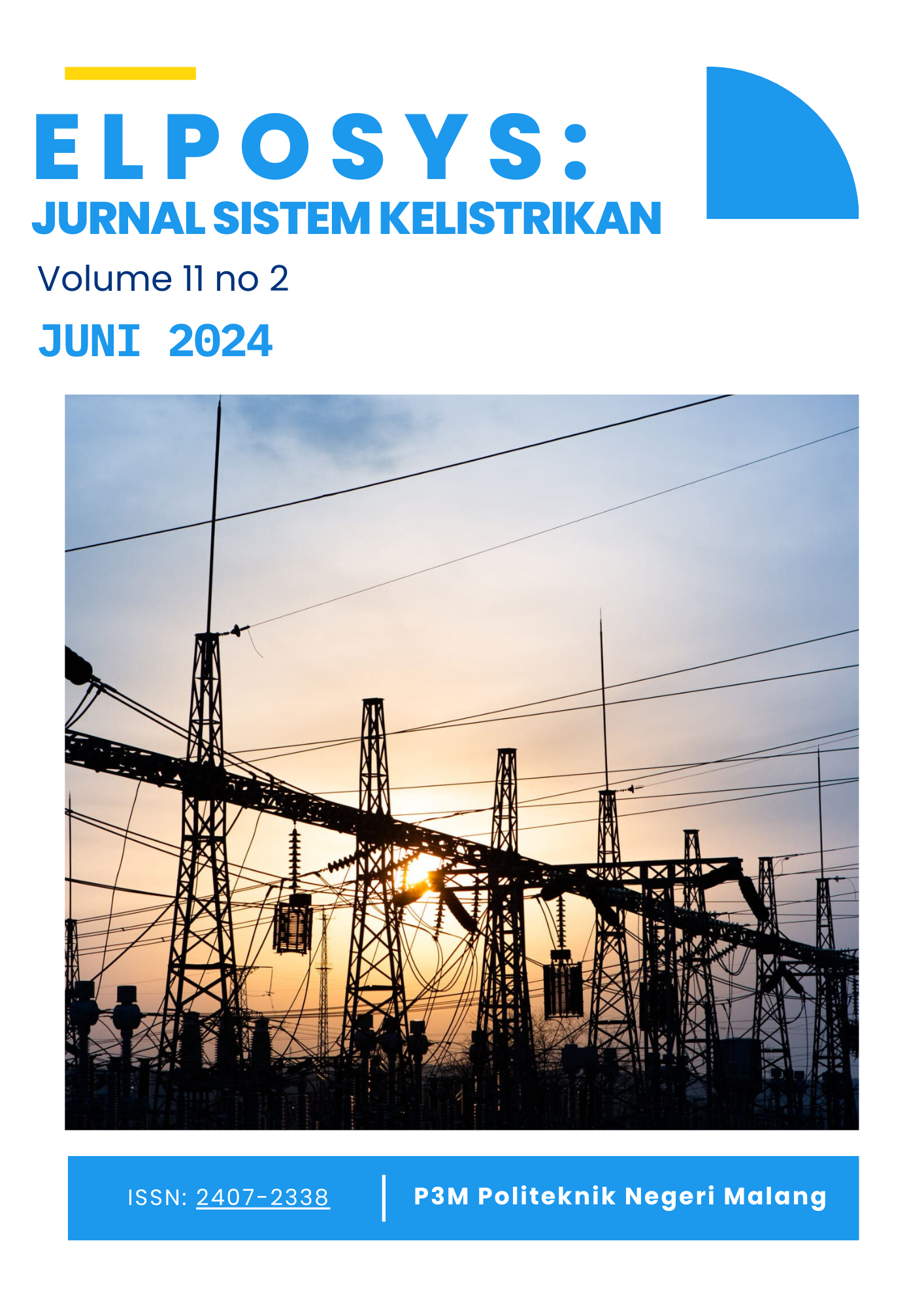Pra-studi Kelayakan Sistem Hibrida PV-Baterai-PLTD di Daerah Pedesaan Wilayah Maluku
DOI:
https://doi.org/10.33795/elposys.v11i2.5165Keywords:
Solar PV, Hybrid system, Pre-Feasibility Study, Renewable Energy, Rural electrificationAbstract
This research addresses the high costs and logistical challenges of diesel-based electricity generation in the rural and remote areas of Maluku. The aim is to assess the feasibility of hybridizing diesel generators with solar photovoltaic (PV) and battery energy storage systems (BESS) to reduce energy costs and environmental impacts. A tailored methodology evaluated 42 locations to determine the optimal hybrid systems. The evaluation included preliminary solar potential, electricity consumption, hybrid options, generation costs, and capital costs. Findings indicate that systems with higher renewable energy fractions are more beneficial, reducing total diesel consumption from 30.5 million L/yr to 5.8 million L/yr and Levelized Cost of Energy (LCOE) from 0.62 USD/kWh to 0.42 USD/kWh. PV sizes ranged from 150-2400 kWp with renewable energy fractions from 80-93%. This method effectively prioritizes economically and technically suitable sites.
References
N. U. Blum, R. Sryantoro Wakeling, and T. S. Schmidt, “Rural electrification through village grids—assessing the cost competitiveness of isolated renewable energy technologies in Indonesia,” Renewable and Sustainable Energy Reviews, vol. 22, pp. 482–496, 2013.
H. Wirawan and Y. M. L. Gultom, “The effects of renewable energy-based village grid electrification on poverty reduction in remote areas: The case of indonesia,” Energy for Sustainable Development, vol. 62, pp. 186–194, 2021.
PT. PLN (Persero) Maluku & Maluku Utara data; PT. PLN (Persero): Jakarta, 2020;
Directorate General of Electricity Statistik Ketenagalistrikan Tahun 2019; 33rd ed.; Directorate General of Electricity: Jakarta, 2020;
J. Morrissey, “Achieving universal electricity access at the lowest cost: A comparison of published model results,” Energy for Sustainable Development, vol. 53, pp. 81–96, Dec. 2019, doi: 10.1016/j.esd.2019.09.005.
Direktorat Jenderal Ketenagalistrikan ESDM Laporan Kinerja Direktorat Jenderal Ketenagalistrikan Tahun 2020; Jakarta, 2021.
W. K. Yap and V. Karri, “An off-grid hybrid PV/diesel model as a planning and design tool, incorporating dynamic and ANN modelling techniques,” Renewable Energy, vol. 78, pp. 42–50, Jun. 2015, doi: 10.1016/j.renene.2014.12.065.
T. Senjyu, D. Hayashi, A. Yona, N. Urasaki, and T. Funabashi, “Optimal configuration of power generating systems in isolated island with renewable energy,” Renewable Energy, vol. 32, no. 11, pp. 1917–1933, Sep. 2007, doi: 10.1016/j.renene.2006.09.003.
S. M. Shaahid and M. A. Elhadidy, “Prospects of autonomous/stand-alone hybrid (photo-voltaic + diesel + battery) power systems in commercial applications in hot regions,” Renewable Energy, vol. 29, no. 2, pp. 165–177, Feb. 2004, doi: 10.1016/s0960-1481(03)00194-0.
P. Bajpai and V. Dash, “Hybrid renewable energy systems for power generation in stand-alone applications: A review,” Renewable and Sustainable Energy Reviews, vol. 16, no. 5, pp. 2926–2939, Jun. 2012, doi: 10.1016/j.rser.2012.02.009.
A. Chauhan, M. Sharma, and S. Baghel, “Designing and performance analysis of 15kwp grid connection photovoltaic system using pvsyst software,” 2020 Second International Conference on Inventive Research in Computing Applications (ICIRCA), 2020.
S. Jin, H. Kim, T. H. Kim, H. Shin, K. Kwag, and W. Kim, “A study on DESIGNING off-grid system Using HOMER Pro - a case study,” 2018 IEEE International Conference on Industrial Engineering and Engineering Management (IEEM), 2018.
V. Motjoadi, K. E. Adetunji, and P. Meera K. Joseph, “Planning of a sustainable microgrid system using homer software,” 2020 Conference on Information Communications Technology and Society (ICTAS), 2020.
C. Nayanatara, J. Baskaran, S. Dharani, V. Kaviya Sri, and E. Kanmani, “Optimization of hybrid energy resources using Homer software,” 2019 International Conference on Computation of Power, Energy, Information and Communication (ICCPEIC), 2019.
O. Krishan and S. Suhag, “Techno-economic analysis of a hybrid renewable energy system for an energy poor rural community,” Journal of Energy Storage, vol. 23, pp. 305–319, Jun. 2019, doi: 10.1016/j.est.2019.04.002.
HOMER Pro., [online] Available: http://www.homerenergy.com [Accessed: 10-Sep-2023]
A. Maheri, “Multi-objective design optimisation of standalone hybrid wind-PV-diesel systems under uncertainties,” Renewable Energy, vol. 66, pp. 650–661, Jun. 2014, doi: 10.1016/j.renene.2014.01.009.
J. Aldersey-Williams and T. Rubert, “Levelised cost of energy – a theoretical justification and critical assessment,” Energy Policy, vol. 124, pp. 169–179, 2019.
Y. Siregar, Y. Hutahuruk, and Suherman, “Optimization design and SIMULATING Solar PV system USING PVSyst Software,” 2020 4rd International Conference on Electrical, Telecommunication and Computer Engineering (ELTICOM), 2020.
S. Mandelli, M. Merlo, and E. Colombo, “Novel procedure to formulate load profiles for off-grid rural areas,” Energy for Sustainable Development, vol. 31, pp. 130–142, 2016.
“Useful life,” NREL.gov. [Online]. Available: https://www.nrel.gov/analysis/tech-footprint.html. [Accessed: 09-Aug-2023].
W. Cole and A. W. Frazier, “Cost Projections for Utility-Scale Battery Storage: 2020 Update.” National Renewable Energy Laboratory (NREL), Golden, CO, Jun-2020.
Downloads
Published
How to Cite
Issue
Section
License
Copyright (c) 2024 Elposys: Jurnal Sistem Kelistrikan

This work is licensed under a Creative Commons Attribution-NonCommercial 4.0 International License.








